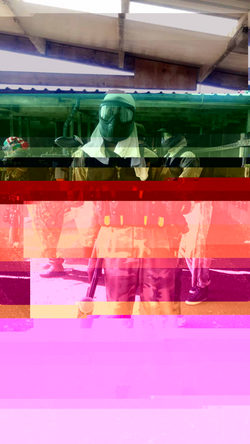CSD3700 DIGITAL MULTIMEDIA ENGINEERING
Glitch Art & Circuit Bending
Glitch art utilizes the breaking/distortion of data, this represents an emerging form of creativity that allows us to relate to digital images as data. Glitches appear in visual art such as the film A Color Box (1935) by Len Lye. According to Menkman (Dec 10, 2011), the Glitch Studies Manifesto author puts it in her somewhat polemical fashion, glitch art is “the product of an elitist discourse and dogma widely pursued by the naïve victims of a persistent upgrade culture” based on planned obsolescence,one prime example is when the television system receives a corrupted signal – misplaced squares, static, jagged frames, freezing, misplaced or inverted colors – and thought “hey, that actually looks pretty cool?”
 |  |
|---|---|
 |  |




images converted to glitch art with online generator
Original Images
ProfessionalGlitch art Examples


A German multimedia designer by the name of Georg Fischer developed a script automates the process his script powers a simple interface that lets you slide bars to adjust the type, size, and prevalence of your glitch. As you tweak each setting, the results appear in real time. There are all kinds of ways to create or exploit a glitch for artistic purposes; not just any computer-based art can be called glitch art (see examples which doesn’t rely on glitches at all https://www.flickr.com/groups/glitches/pool/).
Databinding, for example, is about editing the information contained within the digital file that is used to define an image or photograph. An example of such a change is simply using a binary file editor (hex editor) to manually edit the file's data values. Glitch art has come a long way and is now considered as art and has been accepted by a wider mass there a numerous glitch Studies Manifestos by Patchwork Hedrons, Eelco den Heijer, and Virginia Sotiraki I think their studies are accurate glitch art is amazing I like to refer to it as the art of automation.
Circuit bending is known as the creative, chance-based customization of the circuits within electronic devices with low voltage, battery-powered guitar effects, children's toys and digital synthesizers to create new musical or visual instruments and sound generators. Emphasizing spontaneity and randomness, the techniques of circuit bending have been commonly associated with noise music, though many more conventional contemporary musicians and musical groups have been known to experiment with "bent" instruments. Circuit bending usually involves dismantling the machine and adding components such as switches and potentiometers that alter the circuit. Circuit bending is often practiced by those with no formal training in circuit theory or design, experimenting with second-hand electronics in a DIY fashion.
Inexpensive keyboards, drum machines, and electronic children's toys (not necessarily designed for music production) are commonly used. Haphazard modifications can result in short circuits, resulting in the risk of fire, burning, or electrocution. Aesthetic value, immediate usability and highly randomized results are often factors in the process of successfully bending electronics. Although the history of electronic music is often associated with unconventional sonic results, such innovators as Robert Moog and Léon Theremin were electrical engineers, and more concerned with the consistency and sound design of their instruments. Circuit bending is typified by inconsistencies in instruments built in an unscientific manner. While many pre-fitted circuit bent machines are on offer for sale at auction sites such as eBay, this somewhat contravenes the intention of most practitioners.
References:
Eelco den Heijer. (April 2013). Evolving Glitch Art. Evolving Glitch Art. 1 (3.1), 5-10.
Elizabeth STINSON. (10/09/14). Wonderfully Twisted Photos from a Glitch Art Guru. Available: https://www.wired.com/2014/10/wonderfully-twisted-photos-glitch-art-guru/. Last accessed 2/03/18.
Malika Roy. (December 2014). Glitch IT GOOD: UNDERSTANDING THE GLITCH ART MOVEMENT. Available: http://www.theperipherymag.com/on-the-arts-glitch-it-good/. Last accessed 12/03/18
Patchwork Hedrons. (October 31, 2014). Glitch Art. Available: http://sufficientlyhuman.com/archives/502. Last accessed 12/03/18.
Miles Klee . ( March 22, 2015). The long, twisted history of glitch art . Available: http://kernelmag.dailydot.com/issue-sections/features-issue-sections/12265/glitch-art-history/. Last accessed 12/03/18.
Rosa Menkman ( Dec 10, 2011 ). The Glitch Moment(um). Amsterdam: Network Notebooks. 10-35
Mitchell, A., ‘Glitch Art –Making Art out of Errors’, ArtGallery.co.uk, 17 March 2014, http://www.artgallery.co.uk/blog/post/2014/03/17/glitch_art.aspx, (accessed 17 March 2018)
Khaikin, L., ‘The Radical Capacity of Glitch Art: Expression through an Aesthetic Rooted inError’,ReDefine Magazine, 5 February 2014,http://www.redefinemag.com/2014/glitch-artexpression-through-an-aesthetic-rooted-in-error/, (accessed 4 July 2014).
Mark Wilson. (7/23/14). Shooting Challenge: Glitch Art. Available: https://gizmodo.com/shootingchallenge-glitch-art-1605738665. Last accessed 12/03/18.
Tinwhiskers.net,. (2016). Circuit Bending and Glitch Art | TINWHISKERS.NET. Retrieved 23 March 2018, from http://tinwhiskers.net/circuit-bending-and-glitch-art/.
Vail, Mark: Vintage Synthesizers: Pioneering Designers, Groundbreaking Instruments, Collecting Tips, Mutants of Technology, Backbeat Books; 2.00 edition (March 23, 2018)
Reed Ghazala. (n/a). circuit-bending a bender's guide. Available: http://www.antitheory.com/soundart/circuitbend/cb14.html. Last accessed 20/03/2018.
N/A. (August 23, 2005). Robert Moog: Music Pioneer. Available: https://www.npr.org/2005/08/23/4811694/robert-moog-music-pioneer. Last accessed 20/03/2018.